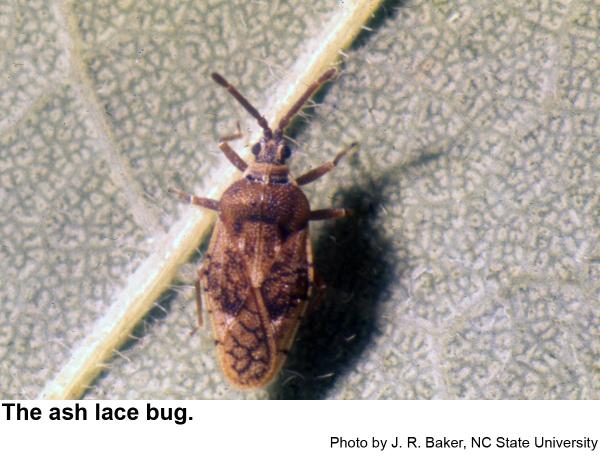Description and Biology
The ash lace bug, Leptoypha costata, is an oval, small, mottled brown insect with the surface of the wings divided into tiny cells. The thorax is closely covered with tiny pits. The antenna are as large in diameter as the legs. Ash lace bug eggs take 9 or 10 days to hatch and the nymphs take about 25 days to mature. The nymphs are sometimes parasitized by tiny midge maggots. The ash lace bug overwinters as adults in sheltered areas. Appropriately enough, the ash lace bug feeds on ash, a member of the olive plant family. A related species, Leptoypha hospita feeds on Chinese privet (also in the olive family). Female Leptoypha hospita lay about 240 eggs each and continue laying until death about 75 days later. The ash lace bug probably has a similar capability. The ash lace bug has three generations per year in Missouri and is likely to have the same number here in North Carolina.
Host Plants
Ash is the usual host for the ash lace bug, but it has also been collected from witch hazel.
Residential Recommendations
A parasitic midge in the genus Endopsylla has been reared from a mature ash lace bug nymph. Perhaps that and other parasites and diseases explain why this species is not noticed more. It is not likely that ash lace bug populations have been sprayed with insecticides to the point that they have developed resistance. Any of the insecticides labeled for landscape use available in nurseries and big box store garden centers should give more than adequate control.
Other Resources
- Biology of Leptoypha hospita (Hemiptera: Tingidae), a Potential Biological Control Agent of Chinese Privet. Yanzhuo Zhang, Y. et al. 2011. Annals Ent. Soc. of Amer. 104(6):1327-1333.
- Immature Stages and Biology of Atheas austroriparius and Leptoypha costata (Hemiptera: Tingidae). Sheeley, R. D. and T. R. Yonke. 1977. Ann. Entomol. Soc. Amer.
- Corrections and Additions to an Article on Leptoypha and Leptostyla (Heteropera: Tingidae). McAtee, W. L. 1919.Buell. Brooklyn Ent. Soc. 14: 142-144.
- Heteroptera or True Bugs of Eastern North America. Blatchley, W. S. 1926. The Nature Publishing Company, Indianopolis. 1116 pp. (Leptoypha costata on pp. 498 & 499)
- The Lace Bugs (Hemiptera: Tingidae) of North Carolina and Their Hosts. Horn, K. F. et al. 1979. North Carolina Agricultural Experiment Station Tech. Bul. No. 257. 22 pp.
- Extension Plant Pathology Publications and Factsheets
- Horticultural Science Publications
- North Carolina Agricultural Chemicals Manual
For assistance with a specific problem, contact your local N.C. Cooperative Extension center
This Factsheet has not been peer reviewed.
Publication date: March 22, 2019
Reviewed/Revised: Jan. 10, 2024
Recommendations for the use of agricultural chemicals are included in this publication as a convenience to the reader. The use of brand names and any mention or listing of commercial products or services in this publication does not imply endorsement by NC State University or N.C. A&T State University nor discrimination against similar products or services not mentioned. Individuals who use agricultural chemicals are responsible for ensuring that the intended use complies with current regulations and conforms to the product label. Be sure to obtain current information about usage regulations and examine a current product label before applying any chemical. For assistance, contact your local N.C. Cooperative Extension county center.
N.C. Cooperative Extension prohibits discrimination and harassment regardless of age, color, disability, family and marital status, gender identity, national origin, political beliefs, race, religion, sex (including pregnancy), sexual orientation and veteran status.

